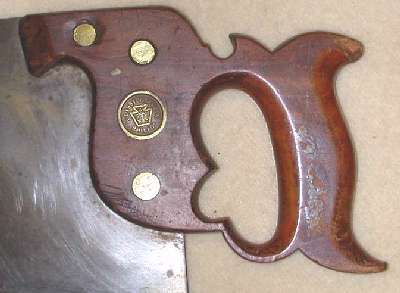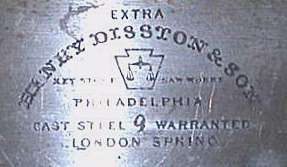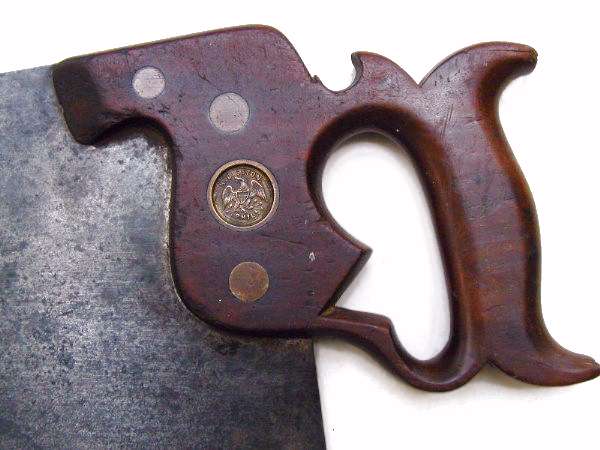
Disston No. 9 Handsaws
|
The Disston No. 9 saw was produced from the 1840's until 1918 or so. The blade is a grade called Extra London Spring Steel, a name for carbon steel with more steps in its production than other blades. The handle is applewood and, sometime after the 1840's, featured a large hand hole for two-handed use. The saw above is from the 1880's. The handle shown to the right is from the early 1850's. It was shaped entirely with hand tools. It appears there were three models of Disston handsaws through most, if not all, of the first decade of production, starting in 1840. The models were the Nos. 7, 8 and 9. The three models had different materials that would have affected the price of the saw. The No. 7 had a beech handle and cast steel blade; the No. 8, applewood and spring steel; the No. 9, applewood and Extra London Spring Steel. | |

The challenge of saw making is getting the right combination of hardness and toughness in the steel. A blade that is too soft won't hold an edge on the teeth for long. A blade that is too hard will not only be difficult to sharpen, but the teeth will break off when they are being set during the sharpening process. Another possibility is that the saw will snap in half if it is bowed in use. It's not difficult to make a saw with Rockwell "C" hardness in the high 40's, but most Disston saws are in the low to mid 50's RC. This results in a blade that doesn't dull quickly. Just for comparison, chisel and plane blades are generally RC 60-62. |
|

|
The saw handle shown here is from the mid-to-late 1860's and has the larger hand-hole. It was during this time that Henry Disston started using bandsaws imported from France to shape the handles of his saws. According to a company history written in 1920, one of the first operators of the intimidating machines was Henry Nicholls, a nephew of Disston, who helped the bandsaw gain acceptance among the workers. Some secondary sources have attributed that role to Hamilton Disston, but he was working in the front office by that time. Another difference between this saw and earlier ones is the etching rather than stamping of the company logo on the blade. The etching began around 1865. |

|

This saw is interesting in that the etch "Henry Disston and Son" dates it to the 1865-1871 period when Hamilton Disston was the only son who was a partner in the company. He was later joined by his four brothers, Albert, Horace, William, and Jacob, in succession.
On the right is a late No. 9 saw handle, from the early 1900's.
|



